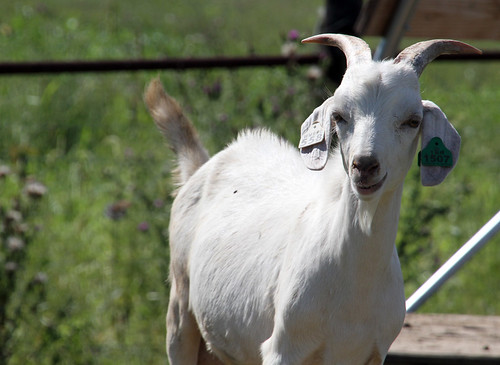For this year's Western Maryland Pasture-Based Meat Goat Performance Test, the fecal egg count data has been summarized.
Fecal samples were collected every two weeks from the bucks. The samples were collected and shipped on ice via FedEx (overnite) to Virginia State University. Dr. Dahlia O'Brien's lab did the fecal analysis. Her lab also did the fecal coprocultures (larvae ID). The last larvae ID is pending. The first pooled sample was 70% Haemonchus, while the second one was 90% Haemonchus.
Upon arrival, fecal egg counts ranged from 0 to 11,900 epg and averaged 2140 + 2530 epg. This was considerably higher than last year. The sequential deworming reduced egg counts in most goats, but was not effective in all. Some producers need to be concerned about multiple anthelmintic resistance in their herds. The median fecal egg count reduction was 96 percent.
Fecal egg counts remained low for the four weeks following treatment. Egg counts began increasing at d-28 (41 days after treatment). While fecal egg counts often increase towards the end of the test, this year’s egg counts were the highest ever recorded in the test, even if the unusually high fecal egg count (of 59,350 per gram) is removed from the data set. The high egg counts and lack of clinical parasitism cannot be completely explained. The supplemental feeding of soy hulls most likely improved resilience.
The first two fecal egg counts are excluded from the data set. The first egg count is most likely a result of past management and environmental conditions. A goat should not be penalized for coming from an environment in which the parasite challenge was greater, as would be expected in the more southern states. Nor should a goat that has been dewormed (already) be given an advantage. The purpose of the test is to identify genetic differences, not to reward goats that come from more favorable production environments.
The second egg count is excluded from the data set because it is the result of the sequential deworming. Most of the second egg counts were very low. A goat should not be penalized for coming from an environment in which the dewormers are no longer (very) effective, though this may limit the ability to effectively treat him, if he becomes paratized during the test. All fecal egg count data that follows a deworming (two weeks prior) is excluded from the data set. In the printouts, these values crossed out.
As previously mentioned, it is not possible to obtain a sufficient fecal sample (2-4 g) from all goats each time (despite multiple attempts). Unfortunately, there is no "fair" way to deal with this problem. A goat should not be given an advantage because he has less data to evaluate. Most of goats in the test had six samples in which to evaluate. For the purpose of selecting the top-10 bucks, only one missing data point (sample) will be permitted.
Download Fecal Egg Count Summary
Download Fecal Egg Count Rankings
Fecal samples were collected every two weeks from the bucks. The samples were collected and shipped on ice via FedEx (overnite) to Virginia State University. Dr. Dahlia O'Brien's lab did the fecal analysis. Her lab also did the fecal coprocultures (larvae ID). The last larvae ID is pending. The first pooled sample was 70% Haemonchus, while the second one was 90% Haemonchus.
Upon arrival, fecal egg counts ranged from 0 to 11,900 epg and averaged 2140 + 2530 epg. This was considerably higher than last year. The sequential deworming reduced egg counts in most goats, but was not effective in all. Some producers need to be concerned about multiple anthelmintic resistance in their herds. The median fecal egg count reduction was 96 percent.
 |
| Click on graph to view larger image in a new window. |
Fecal egg counts remained low for the four weeks following treatment. Egg counts began increasing at d-28 (41 days after treatment). While fecal egg counts often increase towards the end of the test, this year’s egg counts were the highest ever recorded in the test, even if the unusually high fecal egg count (of 59,350 per gram) is removed from the data set. The high egg counts and lack of clinical parasitism cannot be completely explained. The supplemental feeding of soy hulls most likely improved resilience.
The first two fecal egg counts are excluded from the data set. The first egg count is most likely a result of past management and environmental conditions. A goat should not be penalized for coming from an environment in which the parasite challenge was greater, as would be expected in the more southern states. Nor should a goat that has been dewormed (already) be given an advantage. The purpose of the test is to identify genetic differences, not to reward goats that come from more favorable production environments.
 |
| Three of David Peters's bucks had good fecal egg count data. |
The second egg count is excluded from the data set because it is the result of the sequential deworming. Most of the second egg counts were very low. A goat should not be penalized for coming from an environment in which the dewormers are no longer (very) effective, though this may limit the ability to effectively treat him, if he becomes paratized during the test. All fecal egg count data that follows a deworming (two weeks prior) is excluded from the data set. In the printouts, these values crossed out.
As previously mentioned, it is not possible to obtain a sufficient fecal sample (2-4 g) from all goats each time (despite multiple attempts). Unfortunately, there is no "fair" way to deal with this problem. A goat should not be given an advantage because he has less data to evaluate. Most of goats in the test had six samples in which to evaluate. For the purpose of selecting the top-10 bucks, only one missing data point (sample) will be permitted.
Download Fecal Egg Count Summary
Download Fecal Egg Count Rankings











